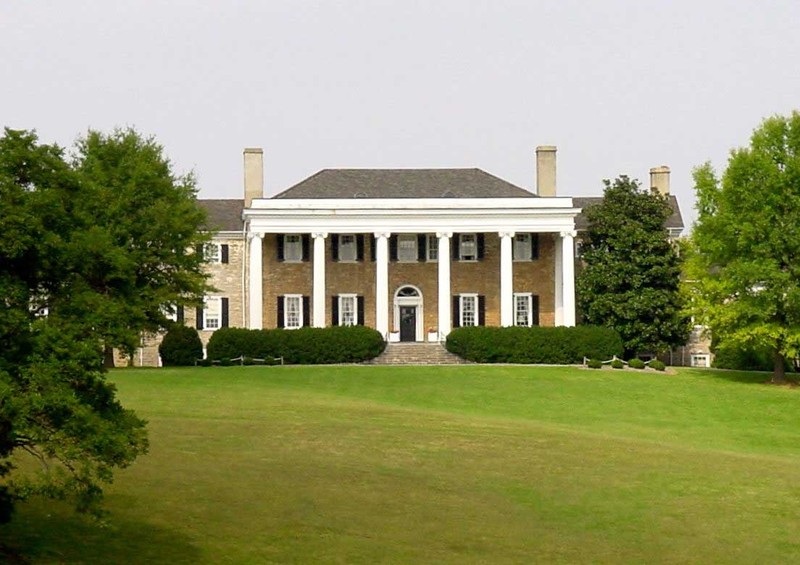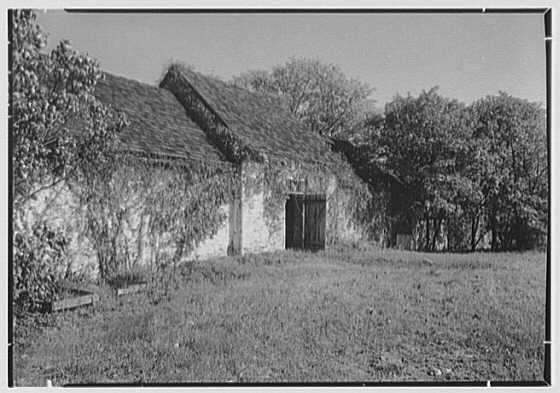Carter Hall
Introduction
Text-to-speech Audio
This mansion was built in 1797 for state politician and businessman Nathaniel Burwell (1750-1814) and it became the centerpiece of a 5,808-acre plantation. The home is a fine example of Georgian architecture, featuring a large portico with Ionic columns, two-story wings on either side of the center portion of the house, and one-story wings at the far ends of the house. The land was part of Burwell's inheritance and the land surrounding the home was left uncultivated until Burwell moved 45 enslaved laborers to his property in 1782. Burwell served in the Virginia House of Delegates, was a member of the Virginia Ratifying Convention, which ratified the U.S. Constitution. He also served as a lieutenant of the James County Militia. During the Civli War, the property was often controlled by the Confederacy and even used as Stonewall Jackson's headquarters for a short time. Carter Hall was a conference center operated by Project Hope, which is an international humanitarian aid organization. As of 2023, it is unused but may become an inn and events center. Carter Hall was added to the National Register of Historic Places in 1973.
Images
The Carter Hall plantation mansion was built in 1797 by Nathaniel Burwell, who was a successful businessman and served a term in the Virginia state legislature. As of 2023, it is unoccupied but may become and inn and events center.

This photo shows the slave quarters near Carter Hall

Backstory and Context
Text-to-speech Audio
In 1771, Nathaniel Burwell inherited the plantation, which had been held in trust after the death of his father, Carter Burwell, in 1756. His great grandfather was Robert "King" Carter (1663-1732), who was one of the wealthiest men in the colonies and served as governor of Virginia colony from 1726-1727. Nathaniel Burwell was born on April 1750, the first of Carter's nine children, at Carter's Grove Plantation, which is located along the James River near the city of Williamsburg. As a young man, he attended the College of William and Mary and graduated in 1771. He also married his wife, Susannah, that year. They had eight children (seven boys and one girl) but sadly she died in 1788. Burwell became a successful businessman and, as noted above, a prominent political figure.
Burwell did not begin to cultivate on the Carter plantation until he transported 45 enslaved laborers to the property in 1782. With Revolutionary War hero Daniel Morgan, they built a wheat mill (the Burwell-Morgan Gristmill) on the Spout Run River in Millwood that slaves operated seven days a week. Burwell built a home at the mill in 1756 that he named Brookside. In 1792, Burwell began to build Carter Hall and it seems the family didn't move in until its completion in 1797. Subsequent owners have built additions and made changes to Carter Hall, including building the portico. The grounds also included two smoke houses, a dairy house, a school house, and a kitchen house.
During the Civil War, Union and Confederate troops camped on the plantation around the mansion in 1862. Confederate General "Stonewall" Jackson made Carter Hall his headquarters, although he opted to camp outside instead of sleeping inside. Interestingly, Jackson's surgeon performed a successful cataract surgery on the current owner at the time, George Burwell. It took place on the portico. Some Union troops ransacked the house, stealing wine and breaking china and glass. Throughout the war, Carter Hall was a popular social gathering place and Confederate troops often went there on furlough.
It appears family descendants owned the property until 1929 when businessman Gerard Lambert bought it. He renovated the interior and exterior, and added electricity, indoor plumbing, and running water. Early in World War II, Carter Hall almost became the summer White House for President Franklin Roosevelt. The elevation was discovered to be too low, however, and Camp David was built instead. Project Hope bought Carter Hall in 1974 and, after the construction of an administration building in 1979, staff moved in. In 2001, the organization began to allow other, similar organizations to use the facilities. Project Hope sold the property in 2021 to a development company who has intended to convert it into an inn and event center. Local opposition has delayed these plans, however.
Sources
"About Us." The Carter Hall Conference Center and Project HOPE. Accessed June 19, 2023. http://www.carterhallconferences.org/about-us.
Powell, Mickey. "Country inn plans for historic Carter Hall to be revised." The Winchester Star. February 5, 2023. https://www.winchesterstar.com/winchester_star/country-inn-plans-for-historic-carter-hall-to-be-revised/article_332d9528-4d3a-596a-9354-c8ef59e36c0e.html.
Turner, Megan N. "Carter Hall: A Landscape History." Garden Club of Virginia. Retrieved from Scribd on June 19, 2023. https://www.scribd.com/doc/296603389/Carter-Hall-A-Landscape-History#.
Virginia Historic Landmarks Commission Staff. "Carter Hall." National Park Service - National Register of Historic Places Nomination Form. July 24, 1973. https://catalog.archives.gov/id/41680186.
Wikimedia Commons: https://en.wikipedia.org/wiki/File:Carter_hall.jpg
Library of Congress https://loc.gov/pictures/resource/gsc.5a02004/
